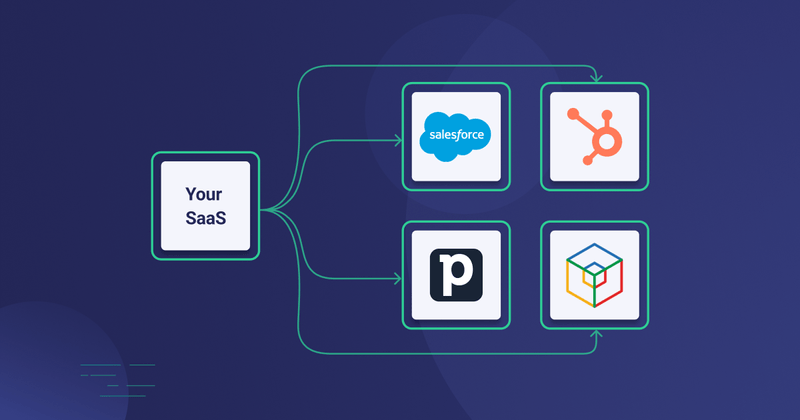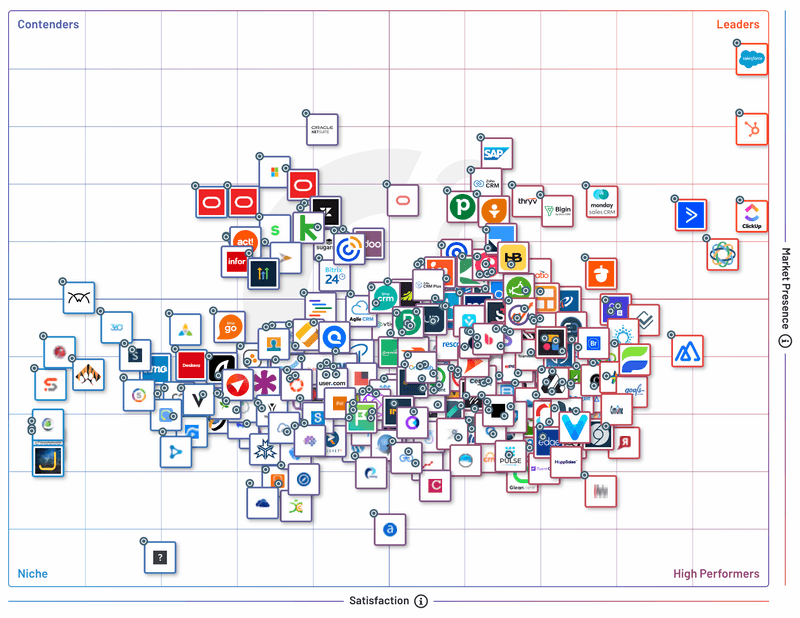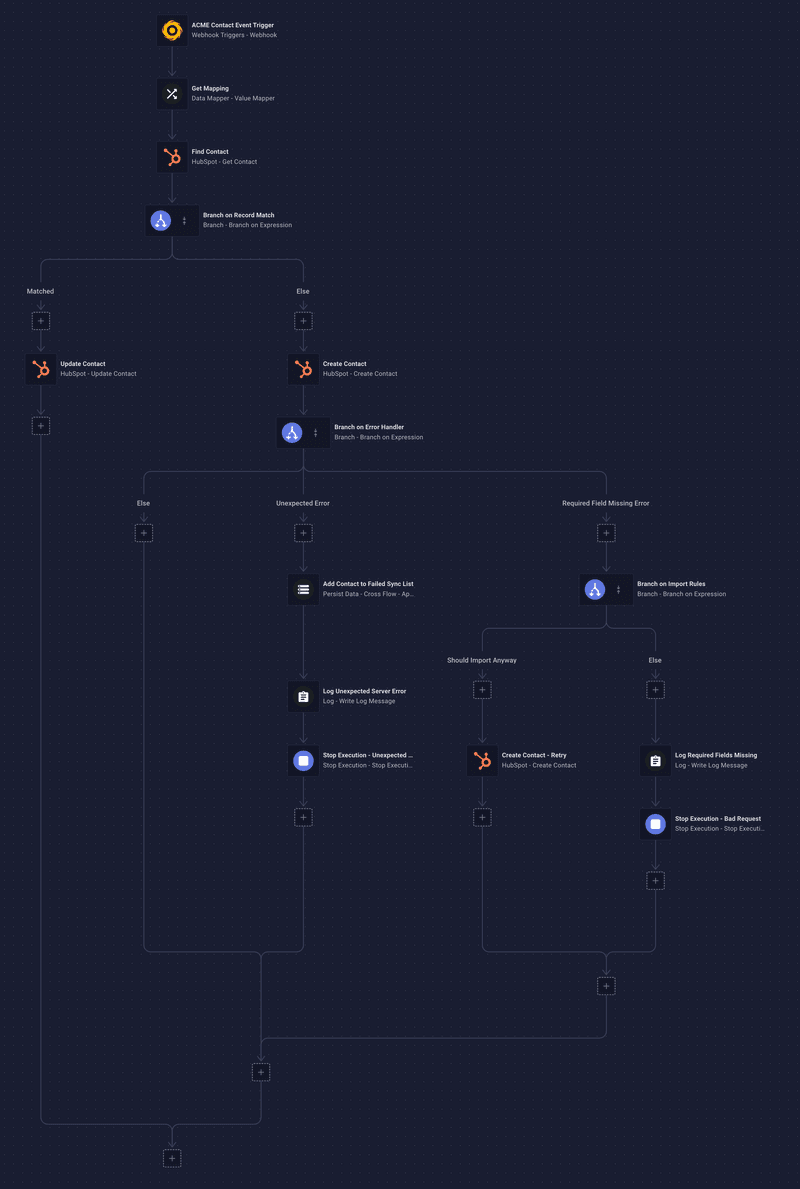CRM Integration for B2B SaaS Companies

You are adding more customers to your SaaS app all the time. And these same customers want you to provide even more value by integrating your app with their customer relationship management (CRM) systems.
Your dev team selects a CRM several of your customers use and investigates what it would take to build an integration. It seems straightforward. The CRM has an API that's been around for a while but looks well structured. Based on initial discussions with a handful of customers, they need a simple one-way data sync between your app and their CRMs. Your dev team agrees it can fit this integration in the next few months.
Then, as you gather more data, you find out that your customers currently use 40 different CRM apps. And that number is only going to increase as your customer list grows. Further digging shows that many of your customers expect complex, two-way integrations with their CRMs.
Telling your customers that you won't build these integrations is a non-starter. If you don't build them, they'll find a vendor with a product like yours who will. Larger customers might be okay with building these integrations themselves, but smaller customers often lack the dev or IT personnel necessary to do the job. Turning your integrations over to a third party means you no longer own the customer relationship. So, somehow, you need to figure out how to provide these integrations to your customers.
The challenge is clear. And there is a way forward. Let's check out CRM integrations in more detail and see how you might best serve your customers.
What is CRM integration?
A CRM integration connects a CRM app and another app for data transfer purposes. This usually makes it a CRM API integration (since most modern CRM apps have corresponding APIs).
Since CRM products help companies manage their day-to-day operations, processes, and resources, these systems are often integrated with most other systems in the company. For example, payroll may be managed via a dedicated payroll system, but the data may be regularly sent to the CRM to be combined with other operating cost data for roll-up reporting.
CRM integrations can be either internal to a company or external (intended for a SaaS company's customers). Internal integrations are built for a single company's use and function entirely within that company's ecosystem. An internal CRM integration may be built from scratch, with its code custom-written by company employees or consultants, or it may be built using an enterprise iPaaS (integration platform as a service). In either case, the integration is designed to address business needs only for that company.
Customer-facing integrations are built by employees or consultants of a B2B SaaS company to enable data transfer between the SaaS company's product and the other apps its customers use. Such integrations may be built from scratch, built with an enterprise iPaaS, built with an embedded iPaaS, or built with a unified API. A customer integration must usually meet broader requirements than an internal integration because it addresses the business needs of several customers.
As you can see from this G2 Grid, the CRM space is quite crowded. Because of this, B2B SaaS companies often find themselves building numerous CRM integrations for their customers.

How do you integrate CRM with other apps?
Depending on your business needs, a CRM integration can be created in several ways. Here are the most common ways companies create CRM integrations.
Code a CRM integration from scratch
Historically, many businesses have chosen to create CRM integrations from scratch. To do this, they use a dev team that writes custom code for each integration scenario. This approach is used for both internal and external CRM API integrations. This approach is not as common as it once was because platforms (enterprise iPaaS, embedded iPaaS, and unified API) are now available to expedite and simplify integration development.
Build a CRM integration with an enterprise iPaaS
Many companies use an enterprise iPaaS to build internal CRM integrations. Many iPaaS platforms include standard API connectors to CRMs and related systems, allowing developers to create internal CRM integrations more quickly than the old way of coding from scratch. Some companies have even used an iPaaS to build customer integrations. However, this adds more challenges to the process because iPaaS platforms don't include the functionality (such as an integration marketplace, customer management, and customer dashboards) necessary to support an excellent customer UX. An enterprise iPaaS is not a good fit for creating customer-facing integrations for CRM.
Want to learn more about Enterprise iPaaS vs Embedded iPaaS?
Check out our comparison of these platforms for the details.
Build a CRM integration with a unified API
A unified API combines multiple APIs within a software category (such as CRM). As such, it can be a good option for a company that must build the same integration with 40 different CRMs (all covered by the unified API). But, unified APIs program to the least common denominator: if 12 of the 40 CRMs have some feature, and the other 28 do not, chances are good the unified API doesn't support that feature. Unified APIs are used for external integrations, but many of these platforms do not include access to customer-specific functionality such as embedded marketplaces and customer dashboards. Unified APIs are unsuitable for building customer-facing integrations to non-standard or custom CRM.
Want to learn more about Unified API vs Embedded iPaaS?
Check out our comparison of these platforms for the details.
Build a CRM integration with an embedded iPaaS
More and more B2B SaaS companies use embedded iPaaS to create customer integrations. These platforms include standard API connectors to CRMs, streamlining the integration build process. However, unlike enterprise iPaaS, embedded iPaaS is optimized for productizing customer integrations, ensuring that the integrations and associated processes will properly scale with customer growth. And, unlike unified APIs, embedded iPaaS supports the configurability and complexity necessary to build integrations for every app in a market horizontal – not just the standard ones. Beyond that, an embedded iPaaS includes all the functionality needed to build, deploy, and support real-world customer integrations for every market sector. However, embedded iPaaS is not a good fit for creating internal-only integrations for CRMs.
Benefits of CRM integration with an embedded iPaaS
Of the options listed above, an embedded iPaaS provides the greatest benefits when building CRM integrations for your SaaS customers. Here are those benefits.
Save engineering time
Building CRM integrations for B2B SaaS customers without using the purpose-built functionality of an embedded iPaaS takes much more dev time investment than most companies can sustain.
An embedded iPaaS includes a low-code integration designer, a library of built-in components, an integration marketplace, an embedded designer, integration deployment and support tools, and a cloud-native infrastructure – absolutely everything needed to build, deploy, and support customer integrations successfully. SaaS teams report dev time savings of up to 80% after implementing an embedded iPaaS.
Increase win rate and sales velocity
An embedded iPaaS allows your team to create reusable, configurable CRM integrations in days or weeks instead of months. Doing so lets you say "Yes" more often when a CRM integration is functionality your prospects need to become customers. Based on the quick dev turnaround supported by an embedded iPaaS, you can frequently include new integrations with customer onboarding.
Customers often want your product to do X, even if X wouldn't necessarily be helpful for your overall product direction. Integrating with a CRM may allow you to offset these functional gaps by giving customers another way to solve those business needs.
Provide a great UX for integrations
When you create CRM integrations for your customers with an embedded iPaaS, you ensure that those customers will have a first-class integration experience.
Further, your customers won't suffer from the classic black-box integration experience, where they rely entirely on your support and dev teams to tell them what is happening with their integration. Instead, customers can enable, configure, and even support their own integrations because they have detailed access to integration configuration, status, log, and alerting data.
Change is a constant, and an embedded iPaaS makes it easy to make needed changes to integrations as you manage and version the underlying code within your standard CI/CD processes.
Improve your customer service
When you use an embedded iPaaS for CRM integration, your integrations run on a purpose-built infrastructure with redundancy, scalability, and security built-in. This greatly reduces performance issues and other problems that can occur with integrations.
Since no time is spent on infrastructure issues, your support team can focus on the integrations themselves. This is where the deployment and support tools built into the embedded iPaaS show their value. You can empower your non-devs to do much of the support traditionally handled by devs.
You can also set up your customers to self-service their CRM integrations, allowing them to resolve many minor issues immediately. Customers can view, configure, monitor, and otherwise directly interact with their integrations without relying on your support teams for first-level support.
Reduce customer churn
Using an embedded integration platform for your customers' CRM integrations can help reduce customer churn by making your product essential to your customers because it's a hub for their other critical apps. The platform can elevate embedded integrations in visibility and value, establishing them as key product differentiators.
For customers, leaving your product with its CRM integrations means removing your app and losing an essential piece of their business workflow automation. Finding another vendor to replace your app plus its CRM integrations drives up the cost of switching, thereby decreasing the probability of churn.
CRM integrations use case
Now, let's look at a CRM integration example. In this example, we are using the ACME app as a stand-in for your SaaS product and showing the integration steps within a low-code integration designer, which is part of an embedded iPaaS. CRM integrations can run the complexity gamut, from very simple to ones with hundreds of steps and many different flows. Our example shows a single flow from a more complex integration.
HubSpot example
Our example is an integration between your ACME app and HubSpot. This integration flow syncs contacts from ACME to HubSpot, but also handles some error situations along the way. This flow runs each time your ACME app creates or modifies a contact.

- We start with a webhook trigger in your ACME app that runs every time a contact record is updated or added.
- Then, we map the data from the webhook payload to meet the HubSpot schema.
- We then attempt to match the contact from ACME to a contact that already exists in HubSpot.
- Based on the match results we enter a branch.
- If the match is successful and the contact already exists, we update that contact.
- However, if the match is not successful, we proceed to create the contact in HubSpot.
- If we are able to create it, we proceed to the end of the flow.
- But, if we can't create it because of either an unexpected error or we are missing a required field, we jump to a new branch.
- For an unexpected error, we add the contact to a list so we'll know to deal with it later, log the error, and stop the flow.
- If we we are missing a required field, we go into another branch to process that.
- In the configuration options for this integration, we have an option that says "Import if Missing Required Field." If that is set to
true, we take the left side of the branch and create the contact in HubSpot anyway. - If, however, the config option is set to
false, we go with the right side of the branch, log the error, and stop execution.
Meet your customers where they are
Whether your customers use common CRMs, or one-off, custom CRMs, an embedded iPaaS allows you to build, deploy, and support integrations between your product and those apps – ensuring that your customers have a first-class CRM integration UX.
Give your teams the power and flexibility to create and manage whatever integrations your customers need, for CRMs and everything else they use.
Schedule a demo. We'll show you how Prismatic supports powerful, reusable, configurable integrations with your SaaS product and your customers' CRMs.
About Prismatic
Prismatic, the world's most versatile embedded iPaaS, helps B2B SaaS teams launch powerful product integrations up to 8x faster. The industry-leading platform provides a comprehensive toolset so teams can build integrations fast, deploy and support them at scale, and embed them in their products so customers can self-serve. It encompasses both low-code and code-native building experiences, pre-built app connectors, deployment and support tooling, and an embedded integration marketplace. From startups to Fortune 100, B2B SaaS companies across a wide range of verticals and many countries rely on Prismatic to power their integrations.
Get the latest from Prismatic
Subscribe to receive updates, product news, blog posts, and more.

